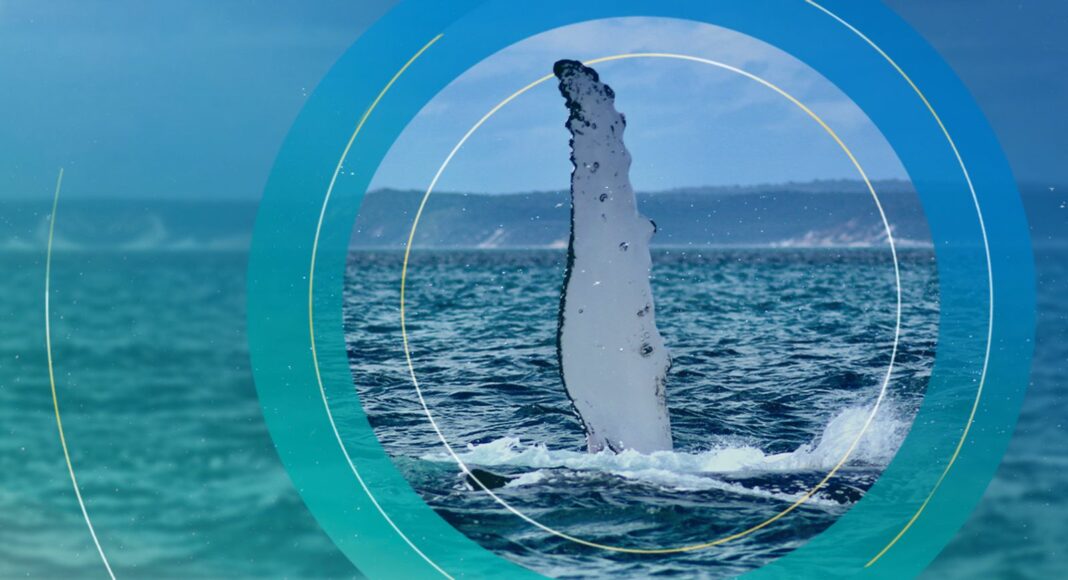During winter Australia’s east coast becomes a migratory superhighway for humpback whales, a so-called “blue corridor”.
Between 30,000 and 40,000 whales make the annual journey from Antarctica to the top of Australia.
A 3,700 mile roundtrip where they socialise and breed in warmer water.
From barely a few hundred eastern Australian humpbacks left in the 1960s, the population is now thriving.
It’s an extraordinary recovery for a species almost wiped out by commercial whaling. It was banned in Australia in the 1970s.
Dr Wally Franklin and his late wife Dr Trish Franklin dedicated their lives to studying the humpbacks at Hervey Bay in Queensland, founding a non-profit research organisation called The Oceania Project.
“It was a remarkable experience to watch the eastern Australian humpback whales recover and begin using Hervey Bay,” he said.
Sky News joined Dr Franklin on a tourist boat heading out from the bay.
“There’s no other place in the world where you get mature females using the bay to look after the young the way it happens here in Hervey Bay,” he said.
It’s a unique location where the whales are protected by the largest sand island in the world – K’gari (previously called Fraser Island).
Scientists estimate that since the end of commercial whaling this humpback population has been increasing by up to 11% every year.
However, they don’t know whether the numbers will remain stable or start to fall as the impact of climate change and global warming take effect.
One of the main concerns is food supply. Whales feed on Southern Ocean krill, small shrimp like crustaceans. As ocean temperatures rise the availability of krill is changing. Without it these giant mammals can’t get enough food and energy for their long migration north.
Griffith University marine scientist Dr Olaf Meynecke said: “We are worried that the animals are starting to starve. But we don’t know yet.”
Dr Meynecke expects “dramatic” changes in the ocean environment over the next decade and says whales are an early warning of what’s to come.
“They are our sentinel species, through them we can find out what is happening in Antarctica and what will happen to other species that depend on that region.”
The whales are already adapting by having their calves further south. Scientists suspect they don’t have enough energy to make it to their old breeding grounds.
The mass migration is also reaching Australia around two weeks earlier than usual. If there isn’t enough krill in Antarctica it’s possible the whales may be heading north earlier to feed on other fish as they make their way to Australia.
Image:
Dr Wally Franklin has dedicated his life to studying humpback whales
Off the Gold Coast, Dr Meynecke and Griffith University Phd student Sarah McCulloch collect samples of whale skin, scooping it up from the sea after the whales breach.
They analyse it back in the lab for viruses and bacteria.
Drones are also used to monitor the whales and keep track of their condition.
Read more:This summer’s heatwave could have been bad for British bumblebeesRiver fish being moved in struggle to survive low water levels’Unprecedented’ wildfires torch record area of EU land to date
With a new generation of scientists working on humpbacks, Dr Wally Franklin can take life a little easier these days.
Dr Franklin and his late wife spent half of their 60 years together studying whales.
Trish was the principal scientist and photographed more than 3500 whales, indiually identifying them by their markings.
Subscribe to the Daily podcast on Apple Podcasts, Google Podcasts, Spotify, and Spreaker
Some whales have been visiting Hervey Bay annually for more than 20 years. To Dr Franklin they are old friends.
As the late afternoon wind picks up in the bay and tourists stroll along the pier, Dr Franklin recalls the heady days of the couple’s pioneering research.
“Every moment I spend with the whales at Hervey Bay is time I’m spending with Trish and remembering those amazing magic moments we had together for over 30 years, just getting a glimpse into the incredible world of these whales.”
Watch the Daily Climate Show at 3.30pm Monday to Friday, and The Climate Show with Tom Heap on Saturday and Sunday at 3.30pm and 7.30pm.
All on Sky News, on the Sky News website and app, on YouTube and Twitter.
The show investigates how global warming is changing our landscape and highlights solutions to the crisis.




